“My Doctor ordered a low sodium diet. Where the heck do I start???”
If your doctor has ordered a low sodium diet for you or for a loved one, chances are, you didn’t get very much guidance of what to do next besides removing the salt shaker from the table.
I definitely had the “where the heck do I start” thought when my husband found out he had heart failure. Even dietitians can have a minor freak out before stepping back to thoughtfully assess a situation. Assisting others in a plan is very different than having to implement that same plan for your own family! So, believe me. I totally get the frustration and overwhelming feeling that you may have going into this new lifestyle because I’ve been there too.
According to the American Heart Association, the average American eats 3,400mg of sodium a day. If you fall into that group, it can be very intimidating to reduce that number by well over 1,000mg per day!
Where to start?
First of all, give yourself some slack and remember to be kind to yourself. Like with all things in life, there’s a learning curve in making this new lifestyle your own.
I find that it’s easiest to take this step by step rather than completely dive in without a game plan. Having some key strategies to set yourself up for success will make the process a lot less frustrating.
I don’t want to get super duper detailed in this post to the point that it’s overwhelming. Sometimes when you’re first starting out with something new, too much information can almost be worse than too little information. I have many more tips which I’ll save for later posts.
Here are a 5 easy action items that I recommend when starting a low sodium diet:
1. Figure out your sodium budget breakdown
How many milligrams of sodium did your doctor recommend? 1,500mg or 2000mg? Maybe more or even less? Totally depends on what condition you have whether it’s hypertension, heart failure, kidney disease, or even Meniere’s Disease. Just like your daily money budget on what you can spend each day, you also have a sodium budget. Take that total number and break it down into your desired number of meals and snacks.
Let’s say your budget is 2,000mg. Perhaps you could break that down like this:
- 500mg breakfast
- 250mg AM snack
- 500mg lunch
- 250mg PM snack
- 500mg dinner
Now you have targets to work with throughout the day.
2. Learn how to read a nutrition label
There’s a ton of info on a nutrition label and it can be a little overwhelming at first. If you’re new to reading nutrition labels, it’s OK! There’s more to it than just looking at the milligrams of sodium. That number listed only represents the amount of sodium in one serving and not the whole package.
For the label listed below, this product contains 160mg of sodium in a 2/3 cup serving, not 160mg in the entire package! Be careful with snack packs and beverages because sometimes it can seem like the entire bottle or pack is 1 serving when in fact it can be more!
I don’t really use the % Daily Value figures on the right side of the label, but it’s helpful to know what they mean. When you see the Daily Value % listed, that number is the percentage of 2,300mg of sodium. Where does that number come from? 2,300mg is the Daily Value for a “normal” diet. 5% of the Daily Value is considered low while 20% is considered high. So, if you see anything higher than 20%, it’s probably a product that you don’t want to buy.
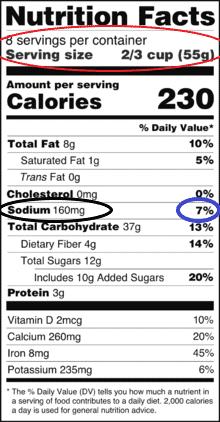
3. Understand sodium claims on the front label
What is low sodium vs reduced-sodium vs very low sodium?? Even I get confused by all of those claims on the front of product packages and I do not have all of these bullet points below memorized. Ugh!! My brain only has so much room for remembering numbers! Even with these claims, you’ll still want to turn the package over and look at the actual amount of sodium per serving.
From the FDA, here’s what these front-of-package claims mean:
- Salt/Sodium Free: Less than 5mg per serving
- Very low sodium: 35mg or less per serving
- Low sodium: 140mg or less per serving
- Reduced sodium: At least 25% less sodium than the original product
(Often times reduced-sodium doesn’t have much importance to me, depending on the product of course. For example, if the original item had 800mg, the reduced-sodium product could still have 600mg. So, keep your eyes open for this type of claim.)
- Light in sodium or lightly salted: at least 50% less sodium than the original product
- No salt added or unsalted: no salt added during manufacturing, but the item could still naturally contain sodium
4. Think of your favorite packaged foods and start looking for lower sodium versions
Of course, you should be cooking with as many whole foods as possible, but I’m sorry, it’s really hard not to eat ANY packaged foods. Some packaged foods are non-negotiables for my husband. For example, cheese is 100% a non-negotiable for him. Most cheese has lots of sodium; however, I found a low sodium shredded swiss/gruyere blend at Trader Joe’s that we use often. This was a huge win!!
Every time you find a new substitute for a high sodium option, I guarantee you will get very excited over this small win! There are lots of low sodium options on the market these days from snacks to bread to condiments to cheese. One by one, you will find some great items! I’m actually keeping a Google spreadsheet with all of my finds and I just started posting about my low sodium product finds on Instagram Stories and Facebook.
5. Bring your lunch to work
Earlier I mentioned that the average American consumes 3,400mg of sodium per day. If you don’t cook at all and mainly eat out in restaurants, you may even be eating more sodium than that already large number.
One of the EASIEST ways to reduce your sodium intake is to lower the number of meals you eat in restaurants. I’ve worked in restaurants for years. Salt is a chef’s best buddy. Something to remember is that many chefs and cooks are smokers and smoking cigarettes can dull taste. So, they may be using more salt because their tastebuds are impaired.
If you can bring your home-cooked lunch to work on most days, you will probably save yourself a good amount of sodium.
- Try bringing a big salad with a protein like grilled chicken or low sodium canned tuna, healthy fats such as pumpkin seeds or nuts and something fun like sliced strawberries. Add a big squeeze of lemon or lime and splash of extra virgin olive oil and you don’t even need to make a real dressing or buy a bottled one.
- Make a few extra portions of your dinner so you can utilize the leftovers for lunch.
- Meal prep by making big portions of whole grains, veggies, and proteins at the beginning of the week and then portioning out lunches in to-go containers for a stress-free lunch.
If you have any favorite low sodium tips that work well for you, I’d love to hear about them!
Pin this post for later!


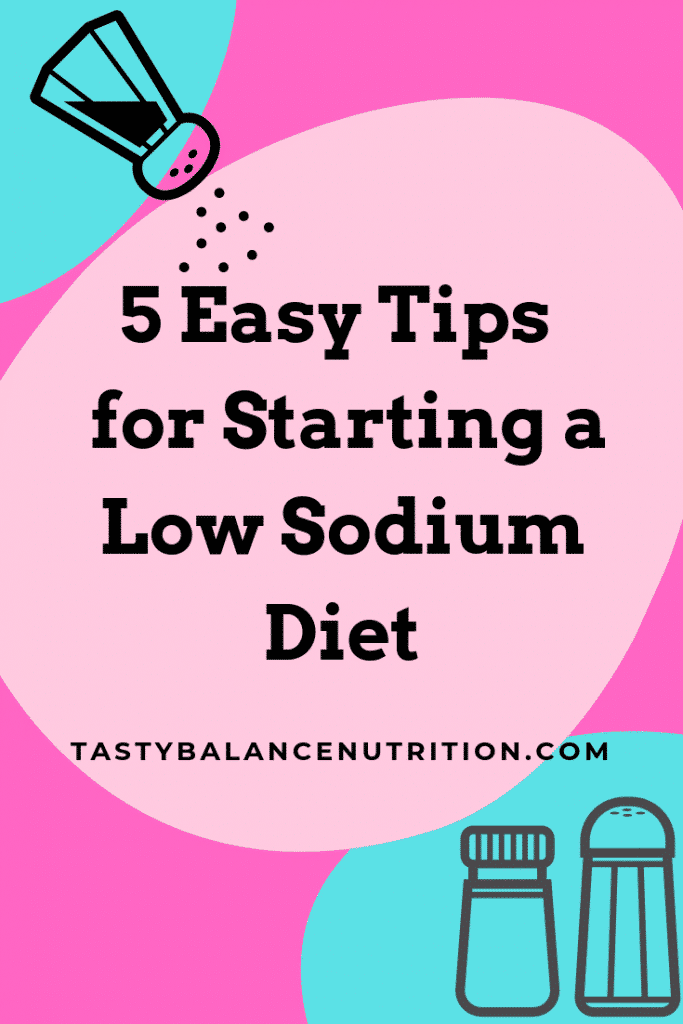

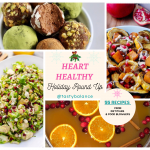
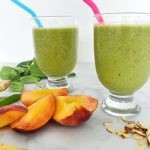
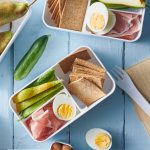
Great tips! Love the last one, homemade food is pretty much guaranteed to have less salt than take out or restaurant food!
absolutely! Thanks Stephanie!
It’s soooo confusing for consumers. Thanks for breaking it all down!
I definitely agree! More easily digestible info is needed.
These are such great, easy to follow tips to help people start on the low-sodium journey. It can be so confusing knowing where to start, especially if you’ve never given your sodium intake a thought.
I know! Up until this point, even I haven’t needed to give sodium too much thought
Love the idea of “budgeting”! It’s important to recognize that you can balance all throughout the day, rather than thinking it must be a stark number for *every* meal. Thanks for sharing!
thanks Stacey!
I love these practical tips. Very helpful for the consumer!
Thank you so much Heidi! I hope they help some folks!
Budgeting! Never would have thought about it! Thank you!
glad that helped!
Such helpful and easy tips! Great post.
Thanks Kara!
Finding no-salt or lightly salted variations of my favorite snacks has been a mental lifesaver! Now more than ever, we scour nutrition labels before anything makes it to our grocery cart. Thank you for the other helpful tips too!
Wonderful! Even finding lightly salted versions of your favorite foods can be really helpful and great for morale!
Great tips!
Thanks Julie!
LOVE – I’m sharing this with a client now! Thanks for the step-by-step 🙂
Awesome! thanks ginger!
You make that want to add Mrs.Dash is salt free and also an awesome seasoning!!
This breakdown was awesome and easy to follow. I was recently put on a low sodium diet by my DR and I was overwhelmed. Now I know where to start. Thank you
wonderful! I’m so happy that it helped! 🙂
Thanks this is the best answer i have ever had
great to hear!